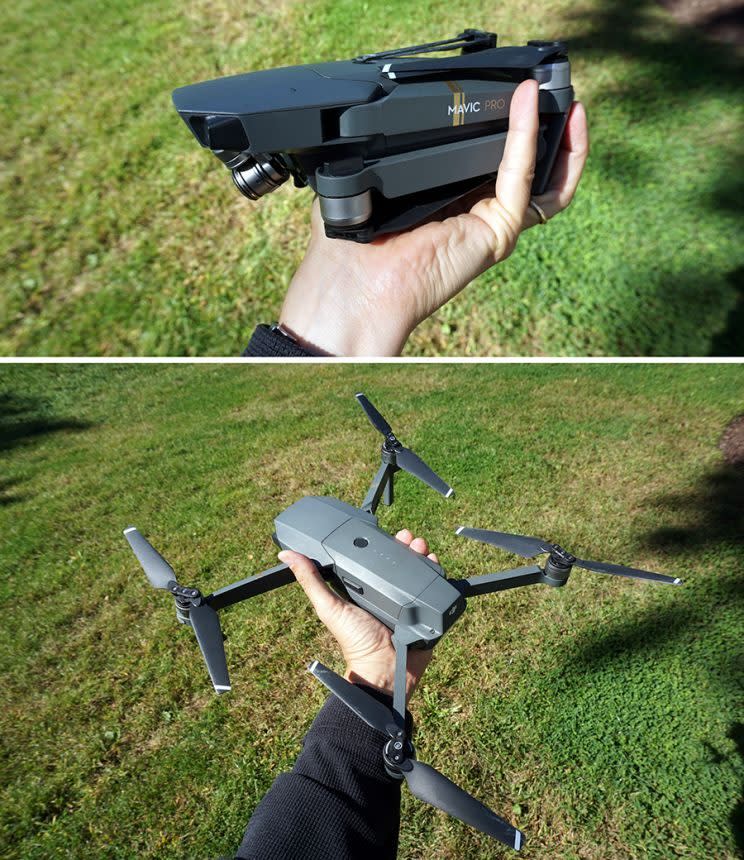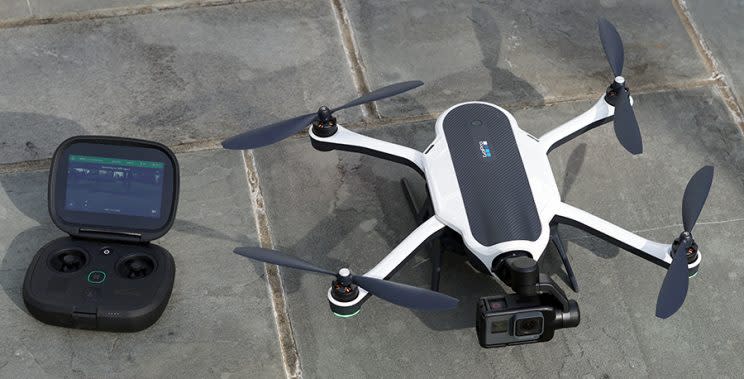GoPro's most exciting mount yet: a drone
Over the years, people have attached GoPro (GPRO) cameras to everything. Thanks to an enormous variety of mounting brackets, they’ve attached this tiny cubical camera to helmets, handlebars, surfboards, skateboards, violin bows, dog collars, ceiling fans, tennis racquets—and a few unusual places, too.
In September, the company introduced the most exciting GoPro mount yet: A drone. It’s called the Karma: $800 for the drone alone, or $1100 with a new GoPro Black 5 camera.

For about a week, the world of athletes, filmmakers, and gadget freaks were truly excited. The Karma seemed to have a world of groundbreaking features: Arms that fold up. A backpack that holds everything. A remote with a brilliant touchscreen, so you don’t have to use your phone as a screen. A companion app that lets a second person operate the camera while you operate the drone. And a stabilizer that pops out of the drone and attaches to a handheld electronic stick, so that you can get equally steady footage on foot.

And then—the Mavic Pro happened.
Dead on arrival?
That would be the new DJI Mavic Pro: a far smaller folding drone—that’s nonetheless more sophisticated, more powerful, and more intelligent than the Karma. (The Mavic is $750 if you use your phone as a screen; $1,000 with controller.)

You can read my full review here, but here’s the short version: The Mavic flies much longer on a charge than the Karma (27 minutes vs. 19). It can fly much farther from you without losing signal (4 miles vs. a puny 0.6 miles). It can fly faster (40 mph vs. 35). It’s much lighter (1.6 pounds vs. 2.2).
And the Mavic’s intelligence features make the Karma look like a relic from 2014. It has front-facing sensors that prevent collisions. It has down-facing sensors that let it hold position indoors, where GPS is unavailable. (You do not want to fly the Karma indoors.)
And the Mavic has “follow-me” mode. How on earth could GoPro release a drone without “follow me” mode?! Seems that like that would be the single most important feature to the target audience of skiers, skaters, bikers, runners, and other active types. (“That’s a sentiment we’ve heard quite a bit,” acknowledges a rep, hinting that this feature might come to the Karma in a future update.)
Article after article after article after article declared GoPro’s drone to be the loser, a 1.0 product that entered the race just as its rivals were crossing the finish line.
But here’s the thing: Even if the timing of the Karma announcement was a disaster, the drone itself isn’t quite.
A water bug in the sky
The Karma looks like it was designed by people who’d heard of drones, but had never seen one. The concepts are all there—four propellers, a remote, a battery—but they’ve been executed radically differently from previous drones.
The shape is bizarrely long and squat. Once you snap its hinged propellers into position for flight, it looks like a big plastic water bug. The GoPro itself seems to hang awkwardly off the nose.

The drone weighs 2.2 pounds, which feels incredibly heavy in the hand. No wonder it gets only 19 minutes of flying time per charge—more like 12 or 13 if it’s windy. (You should subtract at least 5 minutes from any drone’s published flying time, since it automatically flies back to you when the charge gets low.)
At the moment, the Karma requires the GoPro Hero 5, the latest model. Soon, the company says, you’ll be able to get the Karma with a mount for the Hero 4 camera or the new, even tinier Session 5.
And this is where the Mavic loses. Not only is the Hero 5 a far better, more flexible camera than the Mavic’s, but it’s detachable and replaceable. When the Hero 6 comes out next year, you’ll just snap it in. If you buy a DJI Mavic, you’re stuck with the built-in camera forever. That’s a gigantic consideration.
Flying the Karma
When you try to fly the Karma, a few clues announce right away that it’s no DJI drone.
First, the controller needs forever to start up. Second, the Karma claims that it can’t find the GPS satellites unless it’s in a really wide open space; it’s far fussier than its competitors that way.
Like all modern drones, the Karma lifts off to a few feet and hovers when you tap the Take Off button—but its version of hovering isn’t very reassuring. When it’s windy, it wobbles perilously, fighting to maintain position; even in still air, it slowly drifts down and to one side.
Once you start to use the joysticks, the Karma is on much more solid ground (so to speak). Its responses don’t feel as immediate as its rivals’, though.
A controller for the ages
Now it’s time to rave about the controller.
It’s a self-contained, rugged, spectacularly designed little black clamshell. There’s no pairing, no WiFi fiddling, no snapping in a tablet.
The big bright screen is easy to see in sunlight, and the designers clearly fought to keep out clutter and feature creep. You’ve never seen such an elegant, simple set of drone hardware and software.

The left and right joysticks work as they do on any drone (left one controls altitude and orientation; right one moves the drone in the direction you push). Then there’s a Takeoff/Return Home button, a Land Immediately button, a dial for tilting the camera up or down, a button that switches from photos to videos, and a shutter button. And that is it.
No, there’s no “Follow me” mode—a forehead-slapping oversight. But there are four canned flight modes: Orbit (circles a fixed point, camera pointing inward), Cable Cam (flies between two points you’ve established), Reveal (fly straight ahead, slowly tilting camera up from the ground), and Dronie (camera flies up and away from you).
The setup for these shots is ingenious and simple: The screen prompts you to fly the drone in advance to the critical distances and altitudes. For example, for the Orbit mode, it asks you to fly to the center point and tap OK; fly to the outer point and tap OK; then tap Start. (You can adjust the altitude, camera tilt, and drone orientation once the circling begins.)
On this point, well done, GoPro: The Karma, despite its poor specs, is one of the easiest to fly, most confidence-building drones on the market.
The video
GoPro probably has no aspirations for its drone to be used in stunt flying, drone races, or distant pipeline inspections. It has built this drone for one reason: To carry a GoPro aloft. The company may be newbies at designing drones, but it’s wicked good at making video cameras.
The Hero 5’s footage is jaw-dropping. It was born to fly. Color, saturation, detail—up to 4K video—it’s all there. (You can even capture in Protune, which is something like the RAW format for photos: It permits greater fine-tuning on the computer after capture.)
And the stability!
On the day we shot the video above, the wind was blowing at about 20 miles an hour. You can see the flag whipping. You can see the drone tipping perilously in the air. We almost gave up.
But then we saw the footage. I’m telling you, it looks like the drone was on a tripod in the air. It’s rock solid.
That’s a testament to the Karma’s electronic gimbal—its little camera holder that, like a Steadicam, tilts in real time to counteract the drone’s motion. (Part of the Karma’s value is that it comes with that handheld stick, the Karma Grip. You can pop the stabilizer mount out of the drone’s nose and snap it into the Grip, whose electronics keep the GoPro equally steady as you run or move with it on the ground.)
The Hero 5 is loaded with useful settings, all easy to dial up on the Karma’s clear, bright, large-type, easy-to-navigate touch screen. You can choose a wider angle or a narrower one. You can opt to straighten out the barrel distortion that’s typical of very wide-angle lenses. You can take stills, or time-lapse videos.
When the flying’s done, it’s not easy to get the camera out of its mount. But that’s what you must do if you want to see your video; you can’t get at the microSD memory card otherwise. That’s a design boo-boo.
When you do have a look at what the GoPro captured, though, you’re spellbound.
In part, that’s because it also records audio, which the DJI Mavic and similar drones do not. Sure, mostly what you hear is the propellers, but sometimes there’s more: wind, birds, yells from the ground.
A word of instruction
Maybe it’s fine to sell a TV or a router with no more instructions than a Quick Start guide. But a drone? Come on.
To its credit, GoPro offers a flight-simulation mode on the controller’s screen the first time you turn it on. You operate the controls and watch a miniature Karma on the screen respond. It’s a terrific idea.
But after that, it’s all mystery. GoPro’s little booklet doesn’t answer any of these questions:
Why is their a pair of weird wrenches in the box?
Are you supposed to take off the propellers before you put the drone in backpack?
How do I override the 400-foot altitude limit (should I want to do so legally)?
How do I change the video frame rate?
If the fold-up legs are supposed to be down for takeoff, then how can they ever be folded up in flight?
Can I look at the captured footage without landing the drone?
Eventually, a PR rep for the company led me to this site, which is the closest thing you’ll get to a proper Karma manual.
Good Karma?
Oh, to have a Mavic Pro with a GoPro camera on it! That’d be the ultimate.
Instead, if you’re an advanced amateur (or pro on a budget), here’s your tough choice: A spectacular camera on a so-so drone, or a so-so camera on a spectacular drone.
(Or you could get a big complicated expensive drone like a DJI Phantom 4, and put a GoPro onthat. But that size and complexity are a different category.)
Put another way, DJI and other companies are in the business of putting cameras onto their drones. What GoPro has done is to make a drone to put on its camera.

David Pogue, tech columnist for Yahoo Finance, welcomes non-toxic comments in the Comments below. On the Web, he’s davidpogue.com. On Twitter, he’s @pogue. On email, he’s poguester@yahoo.com. Here’s how to get his columns by email.

 Yahoo Finance
Yahoo Finance 
